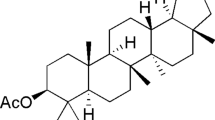Abstract
Successive oral administration (50 mg/kg) of a 50% ethanolic extract (HP-ext) of devil’s claw, the secondary root of Harpagophytum procumbens, showed a significant anti-inflammatory effect in the rat adjuvant-induced chronic arthritis model. HP-ext dose-dependently suppressed the lipopolysaccharide (LPS)-induced production of inflammatory cytokines [interleukin-1β (IL-1β), interleukin-6 (IL-6), and tumor necrosis factor-α (TNF-α)] in mouse macrophage cells (RAW 264.7). Harpagoside, a major iridoid glycoside present in devil’s claw, was found to be one of the active agents in HP-ext and inhibited the production of IL-1β, IL-6, and TNF-α by RAW 264.7.

Similar content being viewed by others
References
Mourice MI (1993) Handbook of African medicinal plants. CRC, Boca Raton, pp 188–189
Jang MH, Lim S, Han SM, Park HJ, Shin I, Kim JW, Kim NJ, Lee JS, Kim KA, Kim CJ (2003) Harpagophytum procumbens suppresses lipopolysaccharide-stimulated expressions of cyclooxygenase-2 and inducible nitric oxide synthase in fibroblast cell line L929. J Pharmacol Sci 93:367–371
Lanhers MC, Fleurentin J, Mortier F, Vinche A, Younos C (1992) Anti-inflammatory and analgesic effects of an aqueous extract of Harpagophytum procumbens. Planta Med 58:117–123
Baghdikian B, Lanhers MC, Fleurentin J, Ollivier E, Maillard C, Balansard G, Mortier F (1997) An analytical study, anti-inflammatory and analgesic effects of Harpagophytum procumbens and Harpagophytum zeyheri. Planta Med 63:171–176
Whitehouse LW, Znamirowska M, Paul CJ (1983) Devil’s claw (Harpagophytum procumbens): no evidence for anti-inflammatory activity in the treatment of arthritic disease. Can Med Assoc J 129:249–251
Andersen ML, Santos EH, Seabra Mde L, da Silva AA, Tufik S (2004) Evaluation of acute and chronic treatments with Harpagophytum procumbens on Freund’s adjuvant-induced arthritis in rats. J Ethnopharmacol 91:325–330
Szekanecz Z, Halloran MM, Volin MV, Woods JM, Strieter RM, Kenneth Haines G 3rd, Kunkel SL, Burdick MD, Koch AE (2000) Temporal expression of inflammatory cytokines and chemokines in rat adjuvant-induced arthritis. Arthritis Rheum 43:1266–1277
Takasugi K, Yamamura M, Iwahashi M, Otsuka F, Yamana J, Sunahori K, Kawashima M, Yamada M, Makino H (2006) Induction of tumor necrosis factor receptor-expressing macrophages by interleukin-10 and macrophage colony-stimulating factor in rheumatoid arthritis. Arthritis Res Ther 8:R126
Lichti H, von Wartburg A (1966) The structure of harpagoside. Helv Chim Acta 49:1552–1580
Nakamura H, Shimizu M (1979) Accelerated granuloma formation in adjuvant-induced arthritic rats and its modification by antirheumatic drugs. J Pharmacol Exp Ther 211:20–25
Huang TH, Tran VH, Duke RK, Tan S, Chrubasik S, Roufogalis BD, Duke CC (2006) Harpagoside suppresses lipopolysaccharide-induced iNOS and COX-2 expression through inhibition of NF-kappa B activation. J Ethnopharmacol 104:149–155
Acknowledgments
This work was financially supported by the “Antiaging Center Project” for Private Universities from the Ministry of Education, Culture, Sports, Science and Technology, 2008–2012.
Author information
Authors and Affiliations
Corresponding author
Rights and permissions
About this article
Cite this article
Inaba, K., Murata, K., Naruto, S. et al. Inhibitory effects of devil’s claw (secondary root of Harpagophytum procumbens) extract and harpagoside on cytokine production in mouse macrophages. J Nat Med 64, 219–222 (2010). https://doi.org/10.1007/s11418-010-0395-8
Received:
Accepted:
Published:
Issue Date:
DOI: https://doi.org/10.1007/s11418-010-0395-8




